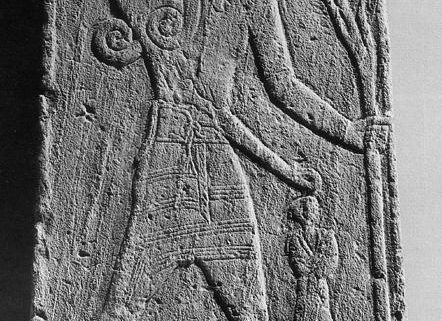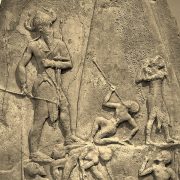Two hundred years after their existence was confirmed by clay tablets found in Mesopotamia, the history of the Amorites is still debated by scholars. We don’t really know the details of their rise and fall, even though it was must have been spectacular. The truth is the Amorites set the cultural and religious tone of Mesopotamia, including Canaan/Israel, for about two thousand years, all the way down to the time of Jesus. So, it’s worth summarizing the history of the Amorites, but I’ll keep it brief—a detailed history would be way too long, mostly irrelevant, and probably boring.
The earliest reference of the Amorites is from about 2600 BC in the ancient city of Shuruppak, in what is Iraq today. The next mentions show up in the archives of Ebla, a city near modern Aleppo that dominated northern Syria from about 3000 BC until about 2250 BC, when it was destroyed either by Sargon the Great of Akkad or by Ebla’s main rival, the kingdom of Mari in southeastern Syria. The discovery of the ruins of Ebla in 1964, confirmed in 1968, included about 1,800 complete clay tablets and thousands of fragments covering a period from about 2500 BC to about 2250 BC.
One of the last rulers of Ebla, a vizier named Ebrium, married his daughter to an Amorite named Tidinu, “chief of the mercenaries.” Because you’re observant, you’ve noticed the similarity between the name of this soldier and that of the legendary Amorite tribe. Apparently, since Ebla depended on foreign soldiers, a marriage to secure the relationship between the government of Ebla and its Amorite contractors was good politics.
This highlights an important point: Even though they weren’t mentioned often in the texts from the third millennium BC, it appears that even at that early date, Amorites in general and the Tidanu/Ditanu in particular had a warlike reputation.
This is reflected in a number of texts found in southeastern Iraq, the heart of ancient Sumer. The “Tidnumites” are among the barbarians blamed for the destruction of Sumerian civilization:
Below, the Elamites are in charge, slaughter follows in their wake,
Above, the Halma-people, the “men of the mountains,” took captives,
The Tidnumites daily fastened the mace to their loins.
Incursions by Amorites, who apparently found a way around the “Amorite Wall That Keeps Tidanu Away,” had weakened the kingdom of Ur by making travel between the cities of Sumer too dangerous for the cheap transport of goods. Imagine the price of a loaf of bread if armed guards had to protect farmers, crops, bakers, and truckers at every step of the process before the bread even reached your local grocery store.
That may have been a picture of the situation in Sumer in the last years before Ur collapsed. Records from the seventh and eighth years of the reign of Ur’s last king, Ibbi-Sin, show that the price of grain skyrocketed to sixty times normal! Finally, weakened by the breakdown in communications between the capital and the edges of its empire, Ur was overrun by invaders from Elam, a kingdom along the coast of the Persian Gulf in what is now western Iran. Around 2004 BC, Ibbi-Sin, the last Sumerian king of Mesopotamia, was carried off to Elam, where he was imprisoned and presumably killed.
This led to a dark age of about a hundred years in Mesopotamia. Despite the many tablets found at major archaeological sites like Ur, Babylon, Mari, and Ebla, scholars really don’t know what happened in the twentieth century BC. All that can be said for sure is that when the dust settled around 1900 BC., Amorite dynasties controlled every major political entity in what is now Iraq, Syria, southern Turkey, Lebanon, and Israel. It was the dawn of the Age of the Amorites.
Until the mid-1800s, the Amorites were known only from a handful of mentions early in the Old Testament. When scholars began pulling clay tablets out of the Mesopotamian sand in the nineteenth and early twentieth centuries, the many references to Amorites they found convinced some that the Amorites had ruled a vast empire across the Near East around the time of Abraham. That wasn’t quite true; divisions between the Amorites, like the rivalries among the tribes of Israel, prevented any of the various Amorite kingdoms from ruling the Near East for very long.
The first Amorite kingdoms to emerge after the collapse of the Third Dynasty of Ur were the city-states of Isin and Larsa. Both were located on the Euphrates in what is southern Iraq today—Larsa, a little north of Ur, with Isin farther northwest, about halfway between the Persian Gulf and Babylon.
These two cities gave their names to the Isin-Larsa period of Mesopotamian history, which covers the time from the fall of Ur in 2004 BC until the defeat of Larsa by Hammurabi of Babylon in 1763 BC.
The first kings of Isin and Larsa were named Ishbi-Erra and Naplanum, respectively. Ishbi-Erra may have been an Amorite. He was described by king Ibbi-Sin of Ur as “a monkey from the mountains,” a “man of Mari with the mind of a beast” who was “not of Sumerian seed.” This suggests that Ishbi-Erra was either an Amorite or an Akkadian from a city that had frequent contact with Amorite nomads. Ishbi-Erra may have put those Amorites to use as mercenaries in support of his ambition to set up his own royal dynasty. (It also tells us something about the attitude of Sumerians toward people from the Amorite homeland in Syria.)
For his part, Naplanum of Larsa was definitely an Amorite. Both were clearly men of power during the last years of Ur. Ishbi-Erra had been made a governor of the territory around Isin and Nippur by king Ibbi-Sin of Ur, but Ishbi-Erra either had more ambition than the king realized, or he took matters into his own hands when it became obvious that the government of Ur was no longer powerful enough to enforce the king’s will. The fact that Ishbi-Erra was either an Amorite or had friendly dealings with the Amorites, the bandits who’d made it too dangerous for most travel and trade in the kingdom, is probably relevant. Ishbi-Erra may have encouraged the turmoil that led to the downfall of Ur, which led to his own rise to power.
Whatever his reasons, Ishbi-Erra became a king in his own right around 2017 BC, and he survived the Elamite sack of Ur in 2004 BC by about twenty years. In fact, Ishbi-Erra eventually marched downriver, drove the Elamites back out of Sumer, and recaptured Ur along with the important cities of Uruk and Lagash.
Meanwhile, Naplanum established a dynasty that ruled Larsa, only about twenty miles from Ur, as an independent city-state for nearly 250 years. Records of grain sales found at Ur mention a wealthy merchant named Naplanum, who may be one and the same, although some scholars believe Naplanum was head of the royal bodyguard for the last two kings of Ur. That could explain how he was able to establish an independent kingdom so close to the throne of his former boss. It also explains the title of rabium amurrim, “chief (or “great one”) of the Amorites,” which was used by the kings of Larsa for generations.
Over time, Naplanum’s successors realized that their location between Isin and the Persian Gulf gave them a strategic advantage over their northern rival. By blocking Isin’s access to the Gulf, the kings of Larsa controlled the lucrative trade route to the Indus River valley (now southern Pakistan), which was home to the prosperous Harappan civilization that reached into India and Afghanistan for nearly two thousand years. The Harappans traded with Mesopotamia and Egypt via the Persian Gulf throughout the second millennium BC, and for the first half of the millennium, that trade was controlled by Amorites.
A pattern that began with Nimrod has continued down to this day in the Near East (and, sadly, around the world): Cycles of war based on strong, charismatic leaders who rise to power, dominate a region and elevate his tribe, culture, or civilization for a time until another leader emerges, the kingdom collapses, and the cycle starts again. It’s like a pot of stew simmering on the stove: Bubbles form, rise to the surface, and burst—over and over. Some bubbles are bigger than others, but all of them collapse in the end. The Amorites didn’t invent the game, but they were very good at it.
During the lifetime of Abraham, who was born around 1950 BC, entered Canaan from the north around 1876 BC, and died in the Holy Land around 1776 BC, Amorite kingdoms emerged to dominate the entire Near East, from the Persian Gulf to the Mediterranean. By the time of Isaac’s birth around 1850 BC, all of modern-day Iraq, Syria, Jordan, Lebanon, Israel, and even northern Egypt were ruled by Amorite kings and chiefs. Regional powers included Isin and Larsa, already mentioned; Mari; Yamkhad, based at Aleppo; Qatna, near modern Homs in west-central Syria; the kingdom of Northern Mesopotamia, centered on what later became Assyria; smaller Amorite kingdoms in Canaan, with Hazor near the Sea of Galilee the largest of those; and the most famous (and infamous) of them all: Babylon.

Derek Gilbert Bio
Derek P. Gilbert hosts SkyWatchTV, a Christian television program that airs on several national networks, the long-running interview podcast A View from the Bunker, and co-hosts SciFriday, a weekly television program that analyzes science news with his wife, author Sharon K. Gilbert.
Before joining SkyWatchTV in 2015, his secular broadcasting career spanned more than 25 years with stops at radio stations in Philadelphia, Saint Louis, Little Rock, and suburban Chicago.
Derek is a Christian, a husband and a father. He’s been a regular speaker at Bible prophecy conferences in recent years. Derek’s most recent book is The Great Inception: Satan’s PSYOPs from Eden to Armageddon. He has also published the novels The God Conspiracy and Iron Dragons, and he’s a contributing author to the nonfiction anthologies God’s Ghostbusters, Blood on the Altar, I Predict: What 12 Global Experts Believe You Will See by 2025, and When Once We Were a Nation.













Leave a Reply
Want to join the discussion?Feel free to contribute!